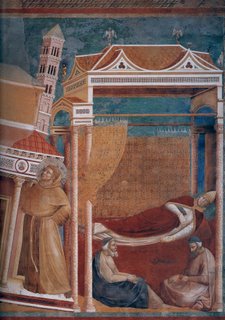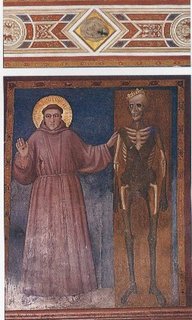
1. We can never fully understand the teachings of Christ. We understand them gradually, thus the concept of the “Development of Doctrines.” Our understanding depends on our Faith, Hope and Charity, but ultimately on the will of God who reveals or withholds truths from us. Many doctrines are implicit in Scriptures. But they are there.
2. Limbo is one concept God withheld for a while, since Repentance, Faith, Hope and Charity were more important. It does not matter how Heaven, Hell, and Purgatory look like. Christians are exhorted to focus and aim for heaven.
3. As with Heaven and Hell, we need Faith to believe in what we cannot see. Attempts to explain matters of Faith are fruitless. But we can only show their reasonableness when based on known truths.
4. The Fathers of the Church did not attempt to explain the mystery of the Blessed Trinity, but they wrote showing its reasonableness. And where ever the Fathers could not fully explain matters of Faith they depended on theological constructs, that is, attempts to make concepts rational.
5. But sometimes constructs can be unclear, and so sometimes seem unreasonable, as what happened with the construct on Limbo. But there is a way of clarifying unclear Evangelical concepts: consult directly the Author, God. We have heard of Saints, like St. Thomas of Aquinas, whose queries were answered by St. John the Evangelist and the Blessed Virgin.
6. Pope Benedict XVI must have ‘consulted’ St. Augustine who, now in Heaven, would know the truth about Limbo. Can you imagine a simpler way? Could this be what the Holy Father did in Pavia when he visited St. Augustine’s tomb?
7.From the time of the early Church, Limbo has been described as a place where the Patriarchs, martyrs, heroes and saints of the Old Testament had to wait, before they could finally enter Heaven and receive their reward, till Christ has fulfilled the Father’s Will to redeem man through His suffering and death. It wasn’t Heaven. But considering that Christ “descended to the dead” before He resurrected, in order to open the gates and free those who were waiting for Him to accomplish His mission, it is welcome news that Pope Benedict has finally cleared up the matter which has been long overdue : Limbo no longer exists.
8.Why should it still exist? To continue believing that it still does would nullify the effect of Christ’s death, which was to open to us the gates of Heaven. This is the reason also why Limbo had also been called the netherworld, for the righteous men of the Old Testament were kept apart from, and could not enter, Heaven till Christ has suffered and died. If the O.T. Fathers who had original sin and committed actual sins, venial or mortal sin, and repented of them, could go to Heaven, why could not unbaptized babies who had no actual sin? Among those whom Christ freed from Limbo when He “descended to the dead” was King David who committed adultery and repented of it. There is Mary Magdalene, also Demas the Good Thief. Would Christ have freed those Old Testament repentant grown- ups and bring them to Heaven and left behind innocent babies?
9.The Holy Innocents were so-called (Holy) because they were martyred for Christ. But they were naturally innocent before this, bearing the image and likeness of God, though tarnished by original sin, before they were slaughtered. If sinners could atone for so many sins and attain an immediate crown of glory with one blow for the sake of Christ, why should innocent babies, still in their pristine innocence, who had no chance to be baptized when they were slaughtered by their own parents who refuse to obey God rather than accept His Will, why should they be forever separated from the lot of repentant sinners who enjoy the beatific vision despite the sins they have committed, if indeed Limbo still exists?
10.When Christ said : “unless you become like children …” “whatever you do to these little ones…” “he who welcomes them welcomes me …” He was pointing at unbaptized children, setting them up as models for those who want to be His disciples. Did He say these to us only to encourage us go to Limbo? He would not have set them up as models for discipleship unless they were meant for Heaven. He also said “Do not prevent them from coming to Me …” If God still holds Limbo in existence, where then is the truth about Him” …. Quae nec fallere, nec falli potest…?”
11.There is a purgatory wherein the “sins of the just” may be expiated before they eventually go to Heaven. If Limbo still exists, children who have never committed any sin will forever be denied Heaven. Such thought militates against both the mercy and justice of God. Would it not be more according to God’s love if He were to rather send unbaptized innocents to purgatory and purge them of their original sin rather than forever cut them off from the vision of God by languishing in Limbo?
12.Come Judgment Day, there will only be Heaven and Hell as final rewards; even purgatory will be obsolete and would no longer exist. But think about those poor, unbaptized babies in Limbo, if God has not forever closed it!
13. The Beatific Vision is a gift of God. If He could freely give this to the patriarchs who have sinned, wouldn’t he to unbaptized, innocent children, for whom He had always shown special tenderness?
14. All Christian doctrines must support each other like a jigsaw puzzle. Maintaining the present existence of Limbo does not fit into the doctrine of Divine Providence which states that God has made provisions to give all a chance to be saved. From this doctrine it is certain He made provisions for unbaptized children. His eternal imaginativeness will certainly find means to save them. (“Origin of the World,” by Wiliam Blake, 1824.)










